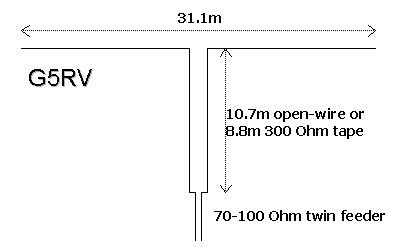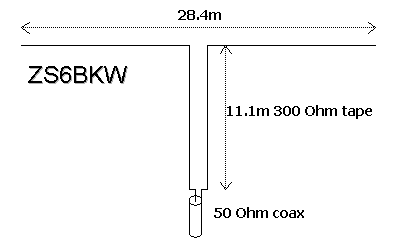The plan is to use a ZS6BKW antenna, in a shallow inverted V configuration. The center will be held aloft at 7m by the Larkspur telescopic mast, with the ladder line feeder running down at an angle to the vertical along one of the guy lines (this keeps it clear of the steel mast). The two 5.4m Clansman masts will then hold the ends of the antenna wires. The antenna wires will be just over 14m of Clansman antenna wire each, run off the spool, with the spools own 40m long throwing lines used to attach it to the 5.4m masts. These throwing lines are so long, that by feeding them down the masts through the holes provided in the guying plates, as the mast manual says, means I can put the two 5.4m masts up in position, then put up the Larkspur mast, and with a little slack in the lines, then haul the dipole center and feedline up the mast using its own halyard. A quick bit of taking up the slack and tying off and were done.
The RT-11 Remote Auto-ATU will then be used, if necessary, with a short RG-214 patch lead from the antenna feeder, and then a longer RG-214 cable from the ATU to the operating position inside the church. Hopefully an on site prior test of the antenna can be arranged (at least one test rigging needs to be done somewhere!), and during this the MFJ ATU will be tried as well. If the manual ATU at the operating position shows no detriment compared to the remote ATU, then the manual one will be used on the day, as that means one less cable to route out the door!
If I can arrange a WSPR beacon, this will operate on 10m using the 10m fibreglass fishing pole mast and the 10m J-pole antenna. Theres little change that the Wispy beacon will be completed, but I could always do this with my FT-857D.
Anyway, time for a bit of blatant plagiarism! Below is a copy of Brian ZS6BKWs original antenna article. Ive done this to save me typing the details of the antenna design, and im sure Brian won't mind too much!
The July 1958 edition of the RSGB Bulletin contained an article by Louis Varney G5RV on a novel multiband dipole which did not require traps. Figure 1 (below) shows the antenna, later to become known universally as the ‘G5RV’.

Like so many good ideas it is so simple. It works as follows: On 20m the flat-top is three halfwaves long. Its feedpoint impedance is therefore low and because the open-wire line is one half-wave length on that band it merely transfers that low impedance to its other end and there presents a reasonable match to the ‘Twin’ feeder on the rig. On 40m the feedpoint impedance is very high (and inductive) because the antenna is now three quarters of a wavelength, but the transmission line transformer is now one quarter-wavelength and so functions as a quarter-wave transformer. Hence the high value of the load impedance, Z(L), is transformed into a much lower value, Z(IN), by the well-known relationship for the quarter-wave transformer:
Z(IN)=Z(O)²/Z(L)
Where Z(O) is the characteristic impedance of the open-wire line, typically 300-600 Ohms. It is rather like an automatic ATU hanging off the antenna! On 15m and 10m the antenna/feedline combination were again said to combine to present reasonable impedances to the twin-feeder, which was all that a valve power amplifier with link or pi-coupling ever requires. The tubes of that era coped far better with mismatches than do the solid-state devices of today!
On reflection, it soon became apparent that one should be able to improve on the performance of this antenna by using a computer to optimise the length of the flat-top and matching transformer such that the impedance presented at the transmitter end of the line more closely matches the 50 Ohms, plus or minus a few, that our modern finals will tolerate.
To do this we need to know the feedpoint impedance of a centre-fed dipole antenna as we change its length and as we change the frequency. This can be calculated but it by no means an easy task and a far simpler approach (and one that is probably more reliable) is to use the data which is available in the professional literature. Professor R W P King at Harvard University had fortunately provided us with this information in tabular form. To use it requires only that it be stored in a ‘look-up’ table in the computer. Given the frequency and the length of the antenna, we then have its impedance.
The next step was to consider the role of the transmission line transformer. How long should it really be and is one value of Z(O) better than another? Without going into any detail here suffice it to say that Louis Varney’s statement, way back in 1958, that Z(O) was not too critical is in fact not far off the mark. It has been shown that there is a broad peak of Z(O) values from about 275 Ohms to 400 Ohms, which will work adequately. This means that either homemade open-wire line or commercial 300 Ohm tale could be used. Do choose the best quality 300 Ohm tape though because that sold for FM-band folded dipoles doesn’t really weather at all well.
To determine the length of the matching section we use the standard transmission line equation which gives us Z(IN) if we know Z(L) and Z(O), the frequency and the length of that line. By re-arranging the equation we can find the length at any given frequency and Z(O) once we’ve used the ‘look up’ table to find Z(L). Of course Z(IN) is fixed by the required standing wave ratio on the 50 Ohm cable to the rig. Usually this VSWR may not be more than 2:1, and is always specified by the transceiver manufacturer.
Armed with this information writing the computer program is a fairly conventional procedure and will not be described here. Ideally a single antenna should operate on all the HF bands from 160 through to 10m. That is a tall order though so we would probably settle for a compromise of say five of the nine bands (including the three new ones.) Having chosen that number we then instruct the computer to change the flat-top length, the length of the matching section and Z(O) until it finds that combination of the three parameters which yield better than 2:1 VSWR on at least five bands. Clearly this involved an iterative or ‘going around the loop’ procedure and can take a fair amount of computer time, but the results are worth the effort.

In Figure 2 (above) are the details of the improved, computer-designed, G5RV. You will notice that the flat-top is shorter than Varney’s and that the matching section is longer. A velocity factor of 0.85 was used for the 300 Ohm tape. Particularly important is the fact that this new antenna is designed for use with 50 Ohm cable and not the 70-100 Ohm twin of 1958. No balun is specified simply because neither the theory nor considerable experimentation justified the inclusion of one. Simply interconnect the 300 Ohm tape and the 50 Ohm coax, taking the normal precautions to keep moisture out.
Both in theory, from the computer predictions, and in practise, when erected horizontally at a height of 13m, the antenna provides an acceptable match on the 7, 14, 18, 24 and 28 MHz bands. The original G5RV was tested by way of comparison (both with the computer and in the field) and found to be far less effective. Only the 14 and 24 MHz bands produced standing wave ratios of less than 2:1 when fed with 75 Ohm cable, as designed.
The new antenna was also tested in the very popular inverted-V configuration and the results showed, not unexpectedly, that the frequency on each band at which the best match occurred were all shifted somewhat lower, but the same general characteristics as discussed above for the horizontal configuration still applied. Likewise, changing the height above ground from 7 to 13m did not markedly change the situation either. It must be realised, of course, that the old dictum ‘the higher the better’ always applies.
Modern technology has been put to work to optimise an antenna conceived empirically nearly 30 years ago and the results should give the old G5RV a new lease of life.
Brian Austin, ZS6BKW
Now, I did intend making some notes here about 'Selby Shorty' and the 20m flagpole stealth vertical, but this has become rather a long and wordy post, so i'll do those on a fresh post instead!
No comments:
Post a Comment